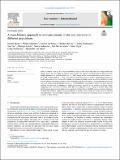A mass-balance approach to evaluate arsenic intake and excretion in different populations
Author(s)
Beene, Daniel; Collender, Philip; Cardenas, Andres; Harvey, Charles; Huhmann, Linden; Lin, Yan; Lewis, Johnnye; LoIacono, Nancy; Navas-Acien, Ana; Nigra, Anne; Steinmaus, Craig; van Geen, Alexander; ... Show more Show less
DownloadPublished version (3.075Mb)
Publisher with Creative Commons License
Publisher with Creative Commons License
Creative Commons Attribution
Terms of use
Metadata
Show full item recordAbstract
Unless a toxicant builds up in a deep compartment, intake by the human body must on average balance the amount that is lost. We apply this idea to assess arsenic (As) exposure misclassification in three previously studied populations in rural Bangladesh (n = 11,224), Navajo Nation in the Southwestern United States (n = 619), and northern Chile (n = 630), under varying assumptions about As sources. Relationships between As intake and excretion were simulated by taking into account additional sources, as well as variability in urine dilution inferred from urinary creatinine. The simulations bring As intake closer to As excretion but also indicate that some exposure misclassification remains. In rural Bangladesh, accounting for intake from more than one well and rice improved the alignment of intake and excretion, especially at low exposure. In Navajo Nation, comparing intake and excretion revealed home dust as an important source. Finally, in northern Chile, while food-frequency questionnaires and urinary As speciation indicate fish and shellfish sources, persistent imbalance of intake and excretion suggests imprecise measures of drinking water arsenic as a major cause of exposure misclassification. The mass-balance approach could prove to be useful for evaluating sources of exposure to toxicants in other settings.
Date issued
2022Department
Massachusetts Institute of Technology. Department of Civil and Environmental EngineeringJournal
Environment International
Publisher
Elsevier BV
Citation
Beene, Daniel, Collender, Philip, Cardenas, Andres, Harvey, Charles, Huhmann, Linden et al. 2022. "A mass-balance approach to evaluate arsenic intake and excretion in different populations." Environment International, 166.
Version: Final published version